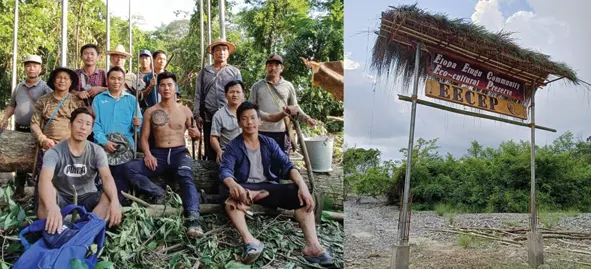
[ Karyir Riba ]
ROING, 3 Jun: The people of Elopa and Etugu villages, comprising the Pulu, Mitapo, Linggi and Menda clans of the Idu Mishmi community of Lower Dibang Valley district have declared a part of their ancestral customary land as a community conserved area (CCA).
The initiative is community-funded.
The official declaration was made on Friday in the presence of local MLA Mutchu Mithi, DC Soumya Saurabh, Lohit CCF Tarun Johri and other officials of the forest department, besides panchayat members, at the Anchal Samiti Hall here.
The official declaration states that the four clans have declared their ancestral land as CCA “to protect ancestral land, wildlife, and Idu Mishmi cultural traditions, passed down to us by our ancestors.”
It also states that the land will “initially be a CCA for 10 years, extendable after consultation with the clan members.”
“This CCA,” the declaration states, “is a way going back to where the clans’ roots lie – where the histories of their ancestors, land, rivers and streams, animals, birds, and fish are deeply interrelated.
“Through this CCA, we plan to conserve, research, manage and use sustainably – in accordance with Idu Mishmi tradition, informed by scientific knowledge, and with an eye to our rapidly changing world,” it reads.
The Idu Mishmi are known globally for their culture of conservation. The CCA, which measures 65 sq kms, has been named the Elopa-Etugu Community Eco-Cultural Preserve (EECEP).
EECEP member Abba Pulu informed, “The acronym EECEP, when pronounced as a word (ee-see-ee-pee) translates to ‘a place we left long time back’ in the Idu Mishmi language. The name itself holds deep meaning for Elopa-Etugu’s clans’ members who were forced to leave their ancestral land in 1980-90s as the Dibang river (Talo) changed course, following years of logging, and swallowed their agricultural fields. The following two decades witnessed increased outsider hunting and resource extraction in Elopa-Etugu’s land.”
Another member, Iho Mitapo, said, “After the flood, our villages had to be abandoned. Nevertheless, we used to listen to stories of how our forefathers lived there, and how abundantly wildlife was found there. This led us youngsters to have deep love and respect for the area, so much that we decided to document the area and its rich flora and fauna. We took the first step by installing camera traps in different parts. Some inaccessible areas were reached by rafting. Some areas did not have drinking water. Our team had to spend nights in makeshift tents. All this hard work paid off when we got back pleasantly shocking results through advanced analysis. We found 40 different types of animals and 100 different bird species.”
Mitapo informed that animals like clouded leopards, two types of Asiatic golden cats, marbled cats, leopard cats, Asiatic wild dogs, Himalayan black bear, large Indian civet, hog deer, and yellow throated marten were caught on their camera traps.
“Binturong and Malayan sun bear have been recorded for the first time in the region. Highly endangered Chinese pangolin, which numbers in less than 7,000 in the world, were also found. We also saw an increase in the number of sambars as they reproduce,” informed Mitapo.
He compared the number with that of the Mehao Wildlife Sanctuary (MWS) and said that, although it is four times larger than the EECEP, the MWS boasts of only 23 species of mammals, which is way lesser compared to the EECEP’s 40.
“Moreover, some animal species found in the EECEP are absent in the MWS. The MWS shows presence of only one clouded leopard, whereas our camera traps at the EECEP captured four. After seeing the results of camera trap surveys, village elders and youths unanimously agreed to take a concrete step to protect the area’s wildlife, ties to land, and rich cultural history – giving birth to EECEP CCA,” he informed.
Clan elder Mutige Menda said, “We have always been dependent on our forests and agriculture. In the early days, our harvest used to be abundant and we could even sell our extra food down here in Roing. Now, however, this has changed drastically. Fish have become scant, most animals have been hunted. Therefore, this step to conserve our land, wildlife and forests is a very welcomed decision.”
The MLA, the CCF and the DC commended the community for taking such a unique step and called it praiseworthy, “as it will benefit all humanity and set an example for the entire state.” All three pledged support to the EECEP.
The MLA informed that the state government is working with the Centre on a legal framework to allow the state’s tribal communities to gain legal land rights over their customary land.
“Such constitutional provisions already exist in Nagaland and Mizoram, but not in Arunachal Pradesh. Such a move, if achieved, should encourage more communities to protect their land,” he said.
CCF Johri said that “the area should not be overlapping with that of reserved forest area to avoid ownership confusion. Requisite approvals or permissions will also have to be sought from the department even if it is a CCA.”
What is a CCA?
A community conserved area (CCA) is an area conserved by communities for cultural, religious, livelihood, or political purposes by customary and other effective means. CCAs differ from wildlife sanctuaries and national parks as local communities take the lead in protecting their land, while also using it for non-destructive spiritual and livelihood purposes.
While CCAs remain a policy challenge in India’s existing legal framework for forest and wildlife conservation, they are a rapidly rising global phenomenon with thousands of communities across the world having declared CCAs in their traditional lands to protect nature, culture, and livelihoods from external and internal threats, particularly large-scale infrastructure development.
Arunachal’s neighbouring state, Nagaland, has close to 700 CCAs, where village councils have legal rights over forest land.
The EECEP has been declared following the customary practices framework which is an accepted form of local governance in Arunachal, and which is recognised by the Convention on Biological Diversity, and the United Nation’s International Union Conservation of Nature’s, to which India is an official signatory.
Within India, the Forest Rights Act (FRA 2006) recognises forest dwelling communities’ rights over their customary lands and empowers them to protect their land by gaining legal titles. However, the implementation of the FRA in Arunachal remains a challenge.
What is the importance of EECEP?
The EECEP is the first locally-led CCA in east-central Arunachal, and second only to the CCAs of Tawang and West Kameng. Importantly, the EECEP is the first community-conserved tropical grassland in all of India.
The EECEP contributes to India’s commitments in the Glasgow COP26, the Paris Climate Accord, and the Convention on Biological Diversity.
The EECEP will be managed by a management committee composed of representatives of all four Idu Mishmi clans. The management committee’s mandate is not only to protect wildlife and restore degraded habitat through a management plan but also to create sustainable income for villagers through community-led research and sustainable tourism.
The EECEP’s objectives also include strengthening inter-generational knowledge transfer and promotion of traditional cultural norms, undertaking programmes to improve the socioeconomic wellbeing and health of the clans’ members, and to prevent large-scale infrastructure development without free, prior and informed consent of the community.
The EECEP’s management committee will seek advice from a local advisory panel composed of panchayat members, the district administration, the forest department, and community leaders, and a technical advisory panel of world-renowned experts who have voluntarily offered support to the novel initiative.
Through the declaration, there is now a complete ban on fishing using generators, explosives, poisons, hunting, and commercial extraction and sale of timber. The land will remain with the community and no single individual may sell, occupy, or reserve land in its name. Traditional fishing and small-scale collection of NTPF is allowed for the community but not outsiders.
The declaration said that, “through restoration, protection, and measured use, we hope to lay the foundation for a sustainable future for our coming generations – a future where we are once again part of nature, not superior to it – a future where economy is linked to generation, not destruction.”





